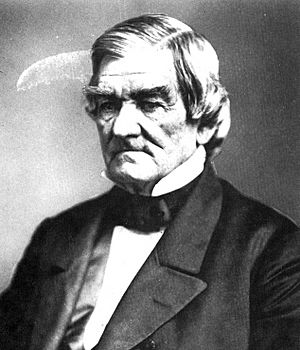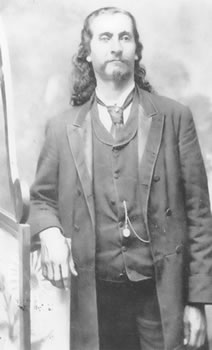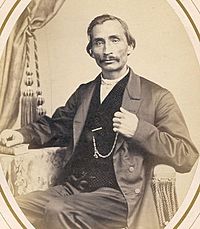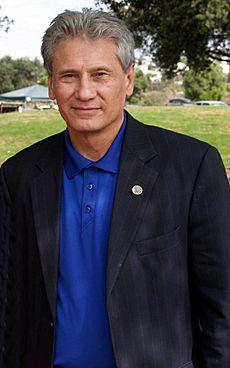List of Principal Chiefs of the Cherokee facts for kids
The Principal Chief is the main leader of the Cherokee Nation, the Eastern Band of Cherokee Indians, and the United Keetoowah Band of Cherokee Indians. These are the three main Cherokee tribes recognized by the United States government today.
Long ago, in the 1700s, the Cherokee people lived in groups based on families (clans) and towns. When they needed to talk with European settlers, they would choose a special leader for these discussions. They called this leader Uku, which meant "First Beloved Man."
The title "Principal Chief" was created in 1794. This was when the Cherokee started to form a more organized government for their whole nation. The Cherokee Nation–East wrote down their own rules in a constitution in 1827. This set up a government with three parts: one to make laws, one to carry them out, and one to decide legal cases. The Principal Chief was chosen by the National Council, which was the law-making group.
Later, in 1839, most of the Cherokee people were forced to move from their homes in the Southeast to what was called Indian Territory (now Oklahoma). This sad journey is known as the Trail of Tears. Once reunited, they adopted one new constitution. Some Cherokee managed to stay in their homelands in North Carolina. Their descendants formed the Eastern Band of Cherokee Indians. In 1868, they also created their own constitution and made the position of Principal Chief official.
In 1906, the U.S. government changed the Cherokee Nation's government structure with a law called the Dawes Act. This law divided up tribal lands and prepared Oklahoma to become a state. After new laws were passed in the 1930s, a group called the Keetoowah Nighthawk Society formed the United Keetoowah Band in 1939. Their constitution was approved in 1940.
For a while, the President of the United States appointed the Principal Chief for the Cherokee Nation. But in 1975, the Cherokee Nation wrote their own constitution again. It was approved in 1976. In 1999, they changed their name from "Cherokee Nation of Oklahoma" to simply "Cherokee Nation."
Contents
- Early Cherokee Leaders
- Cherokee Nation East Leaders (1794–1839)
- Cherokee Nation West Leaders (1810–1839)
- Eastern Band of Cherokee Indians Leaders (1824–present)
- Cherokee Nation in Indian Territory Leaders (1839–1907)
- Cherokee Nation Leaders (1975–present)
- United Keetoowah Band of Cherokee Indians Leaders (1939–present)
- See also
Early Cherokee Leaders
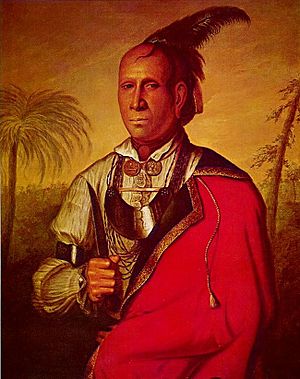
Before 1794, the Cherokee didn't have one main national government. Their society was organized by clans and towns, each with its own leaders. These towns chose leaders to speak for the tribe with British, French, and later American officials. They usually had both peace chiefs (called "white" chiefs) and war chiefs (called "red" chiefs).
The English often translated the Cherokee leaders' titles as "chief." But the Cherokee called their town leaders "Beloved Man." Sometimes, British officials even called a Cherokee leader "emperor." This title was created by a British visitor and wasn't really used by the Cherokee people themselves.
Here are some early Cherokee leaders:
- Outacite (died 1729), a peace chief who signed a treaty in 1720.
- Wrosetasetow, also known as Ama-edohi or "water-goer," was called "emperor" until 1730.
- Moytoy of Tellico (died 1741), declared "emperor" by a British visitor from 1730 to 1741.
- Attakullakulla (1708/1711–1780), known as "Little Carpenter," was a peace chief from Echota. He was seen as the main chief by the British from 1762 to 1778.
- Amouskositte (born around 1728), son of Moytoy, served as "emperor" from 1741 to 1753.
- Old Hop (1753–1756), a war chief from Echota.
- Moytoy of Citico, a war chief during the Anglo-Cherokee War (1759–1761).
- Uka Ulah (died 1761), also called "emperor."
- Standing Turkey (or Cunne Shote), traveled to England in 1762.
- Outacite of Keowee (around 1703–around 1780), also traveled to England in 1762.
- Oconostota (1712–1781), a war chief of Echota, served the whole tribe from 1778 to 1785.
- Old Tassel (died 1788), a peace chief from Echota, served from 1783 to 1788.
- Little Turkey, served from 1788 to 1794.
Chickamauga/Lower Cherokee Leaders (1777–1809)
In 1777, a group of Cherokee, led by Dragging Canoe, separated from other Cherokee bands. They moved to the Chickamauga region (near modern-day Chattanooga, Tennessee) to continue fighting against the Americans during the American Revolution. These Chickamauga Cherokee eventually became a large part of the nation. This separation ended when they reunited with the Cherokee Nation in 1809.
Chiefs of this group included:
- Dragging Canoe (1777–1792)
- John Watts (1792–1802)
- Doublehead (1802–2007)
- The Glass (1807–1809)
Cherokee Nation East Leaders (1794–1839)
After some leaders were killed, Little Turkey was chosen as the "First Beloved Man" of the Cherokee. The main council meeting place moved to Ustanali (later called New Echota) in Georgia. Little Turkey was eventually recognized as the "Principal Chief of the Cherokee Nation" by all the towns after the Cherokee–American wars ended. This was when the Cherokee formed their first official national government.
Principal Chiefs:
- Little Turkey (1794–1801)
- Black Fox (1801–1811)
- Pathkiller (1811–1827)
- Charles R. Hicks (1827)
- William Hicks (1827–1828)
- John Ross (1828–1839)
Cherokee Nation West Leaders (1810–1839)
This group of Cherokee first settled along the St. Francis and White rivers in what was then Spanish land, later becoming Arkansas Territory. They eventually moved to Indian Territory in 1828. Their capital there was called Tahlontiskee.
Principal Chiefs:
- The Bowl (1810–1813)
- Degadoga (1813–1817)
- Tahlonteeskee (1817–1819)
- John Jolly (1819–1838)
- John Looney (1838–1839)
- John Brown (1839)
- John Looney (1839)
- John Rogers (1839–1840)
Eastern Band of Cherokee Indians Leaders (1824–present)
The Eastern Band of Cherokee Indians are descendants of Cherokee people who stayed in their homelands in Western North Carolina. They formed their own group after treaties were made in 1817 and 1819. They were later joined by other small groups who managed to remain in the area during the forced removal of most Cherokee in 1838.
Principal Chiefs:
- Yonaguska (1824–1839)
- Salonitah, or Flying Squirrel (1870–1875)
- Lloyd R. Welch (1875–1880)
- Nimrod Jarrett Smith (1880–1891)
- Stillwell Saunooke (1891–1895)
- Andy Standing Deer (1895–1899)
- Jesse Reed (1899–1903)
- Bird Saloloneeta, or Young Squirrel (1903–1907)
- John Goins Welch (1907–1911)
- Joseph A. Saunooke (1911–1915)
- David Blythe (1915–1919)
- Joseph A. Saunooke (1919–1923)
- Sampson Owl (1923–1927)
- John A. Tahquette (1927–1931)
- Jarret Blythe (1931–1947)
- Henry Bradley (1947–1951)
- Osley Bird Saunooke (1951–1955)
- Jarret Blythe (1955–1959)
- Osley Bird Saunooke (1959–1963)
- Jarret Blythe (1963–1967)
- Walter Jackson (1967–1971)
- Noah Powell (1971–1973)
- John A. Crowe (1973–1983)
- Robert S. Youngdeer (1983–1987)
- Jonathan L. Taylor (1987–1995)
- Gerard Parker (1995)
- Joyce Dugan (1995–1999)
- Leon Jones (1999–2003)
- Michell Hicks (2003–2015)
- Patrick Lambert (2015–2017)
- Richard Sneed (2017–2023)
- Michell Hicks (2023–present)
Two Principal Chiefs of the Eastern Band have faced a process to remove them from office since the late 20th century: Jonathan L. Taylor in 1995 and Patrick Lambert in 2017.
Cherokee Nation in Indian Territory Leaders (1839–1907)
After the forced removal of the eastern Cherokee to Indian Territory, they created a new constitution. This was to unite the former Eastern Cherokee with the Western Cherokee. This new constitution allowed the Principal Chief to be directly elected by the people.
The group led by John Ross built a new capital called Tahlequah. During the American Civil War, the Cherokee Nation voted to support the Confederacy. John Ross agreed for a time. However, in 1862, he and many of his supporters moved to Washington, D.C. At that time, Stand Watie, who was a Confederate officer, was elected Principal Chief by some parts of the Nation. The Ross group never supported Watie's election and continued to live under their own officials.
Principal Chiefs:
- John Ross (1839–1866)
- Thomas Pegg, acting chief for the Union Cherokee (1862–1863)
- Smith Christie, acting chief for the Union Cherokee (1863)
- Lewis Downing, acting chief for the Union Cherokee (1864–1866)
- Stand Watie, Confederate-recognized chief (1862–1866)
- Lewis Downing (1866)
- William P. Ross (1866–1867)
- Lewis Downing (1867–1872)
- William P. Ross (1872–1875)
- Charles Thompson (1875–1879)
- Dennis Bushyhead (1879–1887)
- Joel B. Mayes (1887–1891)
- C. J. Harris (1891–1895)
- Samuel Houston Mayes (1895–1899)
- Thomas Buffington (1899–1903)
- William Rogers (1903–1905); removed from office by the council
- Frank J. Boudinot (1905–1906)
- William Charles Rogers (1906)
Cherokee Nation Leaders (1975–present)
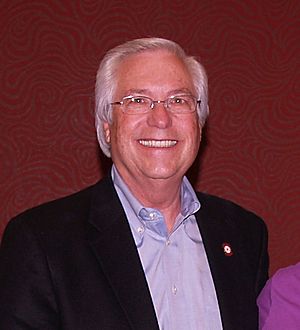
In 1906, the U.S. government ended the original Cherokee Nation's government authority. For many years, the Principal Chief was appointed by the U.S. federal government. In 1971, an election was held, and W.W. Keeler, who had been appointed by President Harry Truman in 1949, was elected.
The constitution for the Cherokee Nation of Oklahoma was written in 1975 and approved on June 26, 1976. A new constitution was approved in 2003, and the tribe's name was changed to simply "Cherokee Nation."
Appointed Chiefs
These "Principal Chiefs" were appointed by the U.S. government, often for short periods, to sign documents and perform other official duties.
- William C. Rogers (1907–1917)
- Charles J. Hunt (December 27, 1928)
- Oliver P. Brewer (May 26, 1931)
- William Wirt Hastings (January 22, 1936)
- J.B. Milam (1941–1949)
- W. W. Keeler (1949–1971)
Elected Chiefs
- W. W. Keeler (1971–1975)
- Ross Swimmer (1975–1985)
- Wilma Mankiller (1985–1995)
- Joe Byrd (1995–1999)
- Chad "Corntassel" Smith (1999–2011)
- Joe Crittenden (acting, 2011)
- Bill John Baker (2011–2019)
- Chuck Hoskin Jr. (2019–present)
United Keetoowah Band of Cherokee Indians Leaders (1939–present)
The UKB Cherokee are mostly descendants of the "Old Settlers" who organized under new federal laws in the 1930s. They approved their constitution and were recognized by the federal government in 1950.
Principal Chiefs:
- John Hitcher (1939–1946)
- Jim Pickup (1946–1954)
- Jeff Tindle (1954–1960)
- Jim Pickup (1960–1967)
- William Glory (1967–1979)
- James L. Gordon (1979–1983)
- John Hair (1983–1991)
- John Ross (1991–1995)
- Jim Henson (1996–2000)
- Dallas Proctor (2000–2004)
- George Wickliffe (2005–2016)
- Joe Bunch (2016–present)
See also


